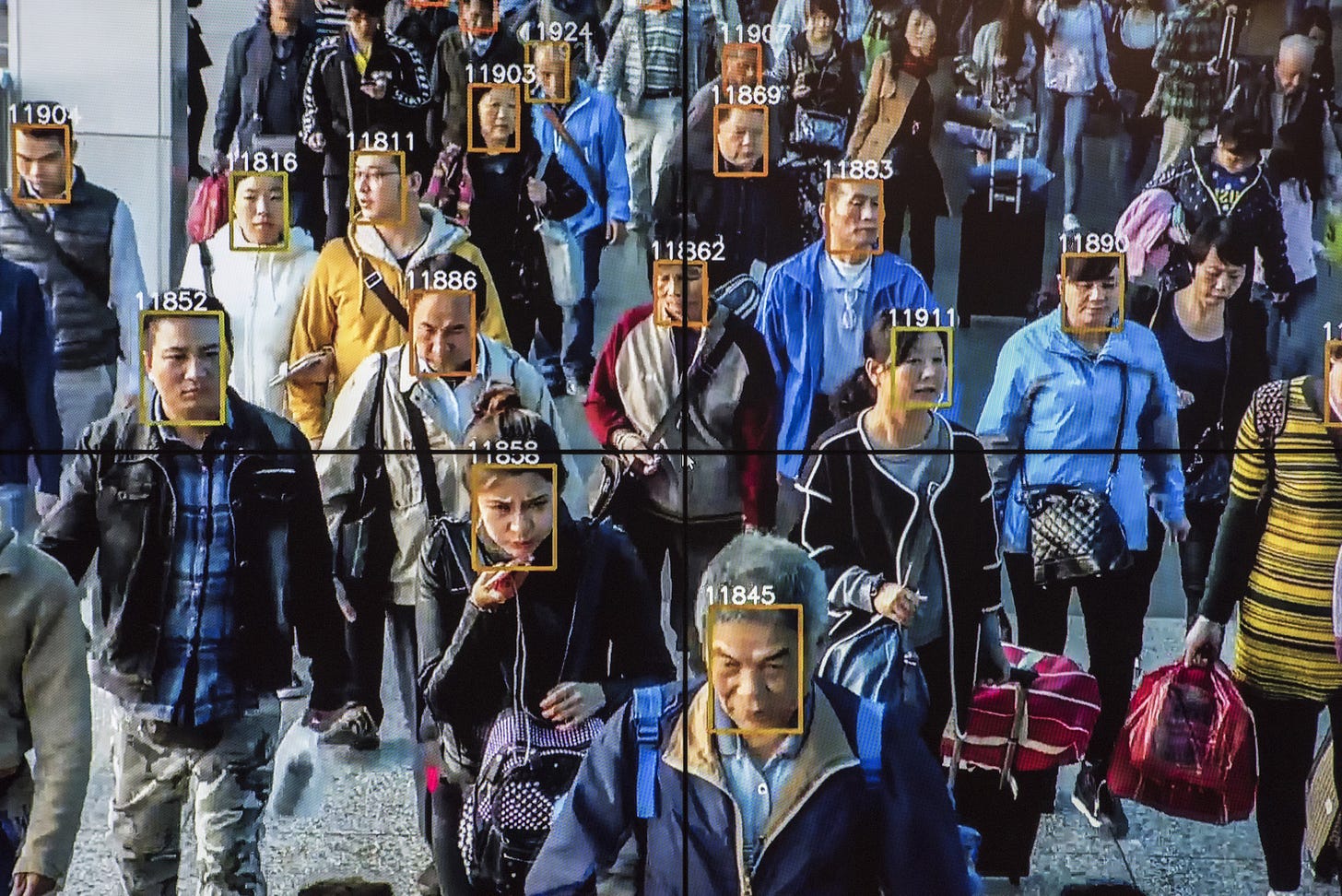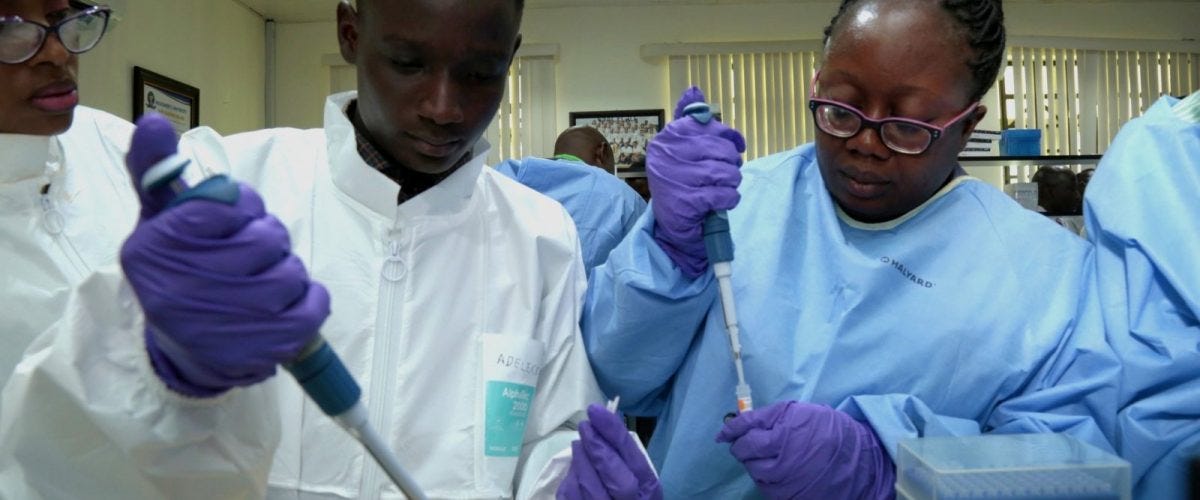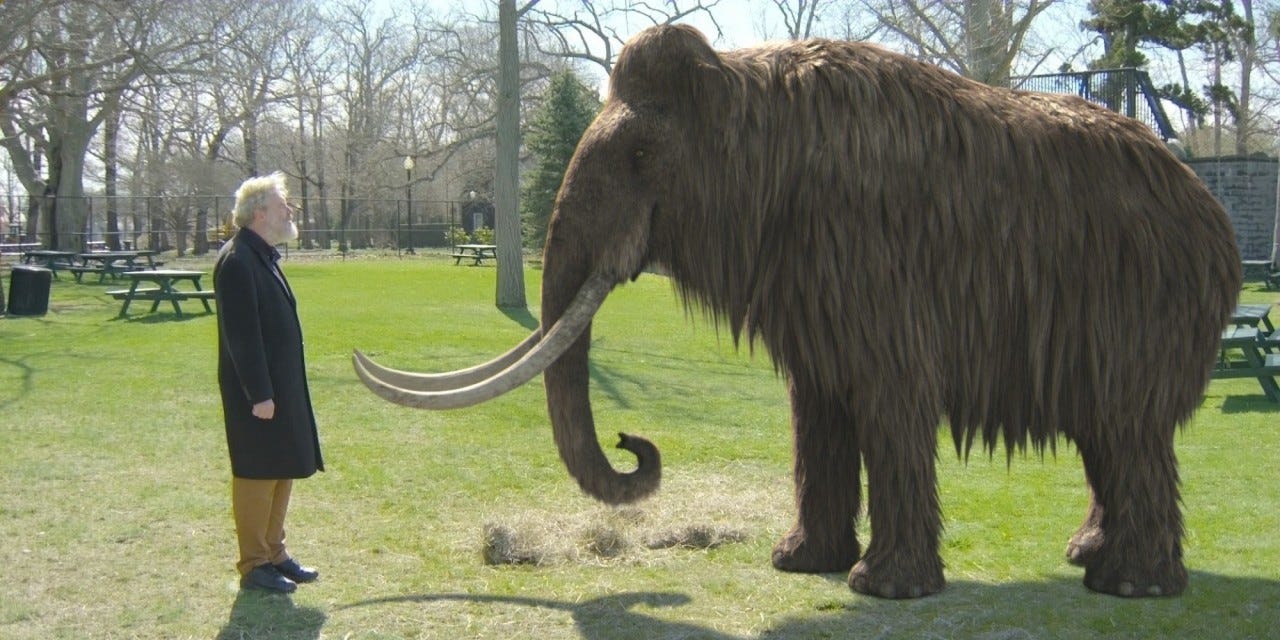How your DNA is being used against you
How your DNA is being used against you
The CDC's Traveler-based Genomic Surveillance Program isn't about health & safety, it's about feeding your DNA to the Vast Machine.

This morning I read about a horse escaping on a Boeing 747 mid-flight.
The plane was already 30 minutes into its flight to Belgium when its unusual cargo broke free of its constraints and that was it—complete chaos at 30,000 feet.
"There's no issue with flying,” the pilot could be heard saying, “but we need to go back to New York as we can't resecure the horse."
Apparently, animals escaping on planes isn’t all that unusual. Last month, an otter and a rat caused mayhem on a flight from Thailand to Taiwan. Earlier this month, a young bear managed to escape on a flight from Baghdad to Dubai.
Animals don’t belong on airplanes. They don’t feel at home high in the sky, it’s unnatural. They have to be heavily sedated to get them through the terrifying experience. I guess they didn’t give those animals enough drugs.
It made me think about what I’m writing today. The governments, corporations and scientists that invest our money (and pay themselves billions of our dollars in the process) to research and experiment on our bodies by altering the very language of life, our DNA, are sure they have everything under control. But what makes them think they can control life and mold it to their will when they don’t even know how it started or the mystery of that spark.
And perhaps one day we ordinary humans will regret giving ourselves over so naively to be analyzed and dissected by these greedy, short-sighted and power-hungry overlords. They promise that their experiments are for our own good, to make us safer, healthier and happier, when their real desire is to extract every bit of information from our DNA in order to create something new and improved—and synthetic.
It was exactly one year ago at the G20 Summit in Indonesia that world leaders signed a “Declaration to Introduce COVID Vaccine Passports”, as well as amendments to its pandemic treaty that would “require swift action by countries and the WHO during an emergency and give the WHO greater powers to act during a crisis”. The plan was to “introduce vaccine passports for their respective jurisdictions, with the stated intention of creating a global verification system to facilitate safe international travel”.
The G20 promised that a Digital Health Certificate using World Health Organization (WHO) standards would be introduced during the next World Health Assembly in Geneva, in May of 2023.
“If you have been vaccinated or tested properly, you can move around. So, for the next pandemic, instead of stopping the movement of people 100%, you can still provide some movement of the people,” Mr. Sadikin said.
What exactly some movement of the people means remains to be seen.
In a statement, the leaders affirmed two goals:
Their respective countries’ support of the WHO mRNA Vaccine Technology Transfer hub, which aims to build capacity in low- and middle-income countries to produce mRNA vaccines. (I wrote about these hubs in Building the mRNA Empire.)
Their commitment to a globalized ‘vaccination passport’.
True to their promise one year ago, on June 2, 2023, the WHO announced the launch of a landmark digital health initiative to be rolled out in Europe:
WHO will take up the European Union (EU) system of digital COVID-19 certification to establish a global system that will help facilitate global mobility and protect citizens across the world from on-going and future health threats, including pandemics.
So far, the U.S. doesn’t have a national inoculation database. However, there are many other ways that our DNA is collected, often without our knowledge or permission. As early as 1990, the FBI began building its treasure trove of DNA. Since then, it has amassed 21.7 million DNA profiles — equivalent to about 7 percent of the U.S. population — according to Bureau data reviewed by The Intercept.
In an April 2023 statement submitted to Congress to explain the FBI’s request to nearly double its current $56.7 million budget, FBI Director Christopher Wray said the FBI collected around 90,000 samples a month — “over 10 times the historical sample volume” — and expected that number to swell to about 120,000 a month, totaling about 1.5 million new DNA samples a year.
What started as a way to monitor violent criminals or sex offenders, is now a way to collect the DNA of any “person of interest”.
But that isn’t all.
Over the years, scientists have been perfecting their methods for collecting DNA and have turned their attention to environmental DNA, or eDNA.
An inexpensive tool for ecologists, eDNA is everywhere — floating in the air, water, snow, food, your last cup of coffee. The eDNA technology is used in wastewater surveillance systems to monitor Covid and other pathogens.
A study demonstrated that scientists could recover medical and ancestry information from minute fragments of human DNA lingering in the environment. DNA of specific individuals can be recovered from spaces such as office buildings, apartment buildings, airports, restaurants.
Recently, researchers descended on the small town of St. Augustine, Florida and, from a “soda-can-size sample of water from a creek”, recovered “enough mitochondrial DNA — passed directly from mother to child for thousands of generations — to generate a snapshot of the genetic ancestry of the population around the creek…. One mitochondrial sample was even complete enough to meet the requirements for the federal missing persons database. They also found key mutations shown to carry a higher risk of diabetes, cardiac issues or several eye diseases”.
Scientists assure us that such eDNA samples will only be used for good by helping to predict pandemics, or uncovering mutations that cause a disease within a community.
Yet, those same eDNA samples could equally be used to find and persecute ethnic minorities or people who are prone to certain illnesses. If you carry it a step further and into the realm of biowarfare, certain groups could purposely be infected with illnesses while the rest of the population would not.
“This gives a powerful new tool to authorities,” said Anna Lewis, a Harvard researcher who studies the ethical, legal and social implications of genetics research. “There’s internationally plenty of reason, I think, to be concerned.”
Countries like China already conduct extensive and explicit genetic tracking of minority populations, including Tibetans and Uighurs. Tools like eDNA analysis could make it that much easier.
Knowing the DNA of an ethnic group means that they could be targeted with biowarfare.
An NIH article Biological Warfare: Infectious Disease and Bioterrorism puts it like this:
Although we rarely perceive it this way, infectious disease is just another manifestation of biological warfare that is ubiquitous throughout life. The evolutionary relationship between hosts and pathogens is essentially a never-ending arms race. When a pathogen evolves a new toxin, the host evolves a response to it. Humanity has taken this arms race one step further by utilizing technology such as vaccines and industrial-scale manufacturing of antibiotics. However, the microbes are fighting back.
Scientists think they can control nature. But they have no idea the long-term consequences of their actions. As humanity’s natural immune system is destroyed by toxic chemicals, drugs, and the very technology that we are promised will save us, experts aren’t suggesting we return to natural remedies and a healthier lifestyle, rather we must ingest more and more of the synthetic drugs perpetuating our illnesses.
Those who get richer and more powerful thanks to the drug and surveillance industries, know very well the dangers this course poses for humanity, yet they keep doing it anyway. It is a way to keep the populace docile and under their control.
Any DNA floating around can be used by authorities to track the populace, to incriminate a person, or to biologically attack them.
Recent developments in synthetic biology—which the National Academy of Sciences defines as “concepts, approaches, and tools which enable the modification or creation of biological organisms”—pose a profound threat. Synthetic bioweapons (SNBWs) can be engineered to target very specific populations or individuals.
Once your DNA leaves your body, it is no longer yours. What are the rules of privacy then? They do not exist. It is a free-for-all.
“Just by breathing, you’re discarding DNA in a way that can be traced back to you,” Lewis said.
If authorities collect your DNA, it doesn’t just affect you, it also affects “family members and, in some contexts, communities,” said Sandra Soo-Jin Lee, a biomedical ethicist at Columbia University.
“DNA tracks to your extended relatives, tracks forward in time to your children, tracks backward in time to your ancestors,” Ms. Murphy added. “In the future, who knows what DNA will tell us about people or how it might be used?”
Which leads us to the CDC’s announcement of its new Traveler-based Genomic Surveillance program.
International travelers arriving at participating airports can volunteer to self-collect nasal swab samples which are then shipped to a laboratory network. Samples that test positive for SARS-CoV-2 undergo whole genome sequencing to determine variants.
However, do not think this is in any way just about Covid. Covid was the excuse to set up a system tracking and monitoring ordinary citizens.
The CDC and Gingko Bioworks are leading the Future of Disease Surveillance:
According to Ginkgo’s press release:
Concentric by Ginkgo, the biosecurity and public health unit of Ginkgo Bioworks, and XpresCheck by XWELL, are partnering to expand their work with the CDC to monitor more than 30 new viruses, bacteria, and antimicrobial resistance targets including several seasonal respiratory pathogens, such as influenza A and B, RSV, and SARS-CoV-2. The partners continue to help the CDC grow TGS's capabilities to detect pathogens as early as possible, allowing for the best public health response.
The program expansion will launch at four of the program's seven major international airports (New York, JFK, San Francisco, Boston, and Washington DC, Dulles).
The TGS program has proven to be an agile and beneficial asset to public health officials in the United States—quickly adapting to an evolving pandemic in real time since it launched in 2021. As of October 2023, TGS has enlisted over 370,000 travelers and maintains an ongoing enrollment of around 6,000 volunteer travelers weekly. The program covers travelers from all World Health Organization regions and more than 135 countries. Since its inception, the program has sequenced more than 14,000 samples and made the genomic data available on several public health platforms to enable further analysis. The expansion will enhance the program's ability to monitor and change focus as needed to identify priority pathogens. The TGS program can augment global surveillance systems, especially as testing and sequencing information become limited as Covid-19 monitoring wanes.
“We thank the volunteers who elect to swab their noses in service to our national security and public health.” ~ ExpresCheck CEO Ezra Ernst
So, what is GINKGO BIOWORKS?
It’s a one-stop-shop that describes itself as “BIOLOGY BY DESIGN”. You can go on the website and “explore Ginkgo’s capabilities for therapeutics and vaccines, agriculture, nutrition and wellness, and more”.
Since 2015, when Gingko was the first biotech company to be accepted for seed funding by Y Combinator, Ginkgo has raised $429 million, which includes $275 million in funding from Bill Gates’ Cascade Investment and others. Ginkgo is reportedly now worth over $1 billion.
Ginkgo Bioworks is the leading horizontal platform for cell programming, providing flexible, end-to-end services that solve challenges for organizations across diverse markets, from food and agriculture to pharmaceuticals to industrial and specialty chemicals. Ginkgo's biosecurity and public health unit, Concentric by Ginkgo, is building global infrastructure for biosecurity to empower governments, communities, and public health leaders to prevent, detect and respond to a wide variety of biological threats.
Here are some of the ways Gingko Bioworks is extending its reach:
Gingko Bioworks is partnering with Penn State University to “integrate its biosurveillance capabilities into the university's research of 58 wildlife species for SARS-CoV-2 to monitor potential spillover to humans”.
It is setting up a BIO4 campus in Serbia, an initiative that has already gathered “more than 1,000 PhD scientists from 17 scientific institutions, and the campus itself will open in 2026. BIO4 brings together the research centers of companies active in biomedicine, biotechnology, bioinformatics and biodiversity. Partnerships have already been signed with AstraZeneca, BGI, Merck, Pfizer, Roche, and more.
To feed a rapidly growing population on a warming planet, society needs to develop innovative new technologies to grow and distribute food. At Ginkgo, we are working towards a future where genetic engineering can help make foods that are sustainable, healthier, delicious, and accessible to everyone.
In 2017, Gingko acquired Gen9, where scientists “manipulate DNA” to create “new life forms that do things we tell them to do”. They are “building nanobot factories that will produce microscopic biological machines programmed to make things more efficient and effective”. They are “dissecting organisms and putting them back together to make biological nanobots that perform functions for their creator”.
One of these legendary creators, and a founder of Gen9, is George Church, who in 2018, co-founded Nebula Genomics, a personal genomics company that offers a “whole-genome sequencing service”.
In fact, the company is developing its own blockchain. It claims it will help you “decode all your genes and identify mutations”, “learn about the genetics of your mind”, “use genetic information to extend your life”, and so on. All of this can be yours, in exchange for your “genomic and personal data” so that you can “contribute to future discoveries”.
Yes, everyone wants your data, they are just salivating to get it.
Bill Gates is another one of those creators who is investing big in genomic surveillance and genomic sequencing, along with Gingko, the US CDC and Africa CDC.
Africa Pathogen Genomics Initiative, which launched in 2020 as a joint initiative of the Africa CDC and member states of the African Union.
Dr. David Blazes, Deputy Director on the Gates Foundation’s Global Health team: We’ve really seen this initiative take off in the past year. For example, at the start of 2021 there were about 5,600 sequences of SARS-COV-2 in existence and by the end of 2021, there were over 60,000. The initial plan was to phase-in labs in 20 countries over four years, but the initiative has already expanded to 45 countries.
Short term goals involved Covid, but Covid was just the beginning. As Dr. Blazes explains, “In the medium-term, we hope that the initiative is able to also address cholera, yellow fever, tuberculosis, and other diseases. Longer term plans include building links between genomic surveillance and local manufacturing of diagnostics, medicines and vaccines. We’ll also be eager to see the types of networks that are built between labs—as well as ministries of health and the Africa CDC.”
How far are we willing to go in giving up our data to the Vast Machine and those who are feeding it. We cannot even breathe without our DNA being collected and analyzed. But don’t worry, it’s all for the greater good, just like George Church assures us.
Prof. George Church’s the Human Genome Project-Write is developing technologies for large-scale engineering of human genomes. Thanks to advancements in synthetic biology, he dreams of reviving the woolly mammoth by inserting mammoth DNA into elephant skin cells which can then be turned into stem cells and used to produce embryos.
This is called “creating the world of tomorrow”.
But it’s not really about making you or me healthier, it’s not really even about bringing woolly mammals back to life, although that’s a great selling point. Once again, all roads lead back to the elites wanting to live forever—and using us as lab rats to do so.
Here’s the scruffy, bearded, elderly Church telling Stephen Colbert how he expects to live forever.
Church excitedly tells Colbert how he’s demonstrated age reversal in animals and Colbert jokingly asks if he cuts a check could he maybe get on the list of folks who will be made younger?
“It’s who you know, that’s how you live forever,” says Colbert.
It’s a joke, but it isn’t really.
Nope, your DNA isn’t being collected at the airport because the government cares about your health and safety and whether or not you have the flu and if you might pass it on to someone else.
It’s all about collecting masses of DNA from the populace, feeding it to the Vast Machine to read and interpret it, using CRISPR to edit it—which I didn’t go into here, but I have in other essays such as Techno Eugenics—so that a new race can be born that will live forever.
No matter which way we turn, all roads seem to lead to this unattainable destination. Just like the horse let loose at 30,000 feet, they aren’t going to be able to put this genie back in the bottle.
Source: Break Free with Karen Hunt



Comments
Post a Comment